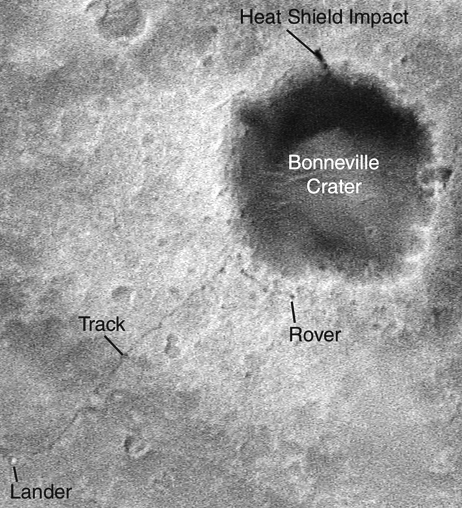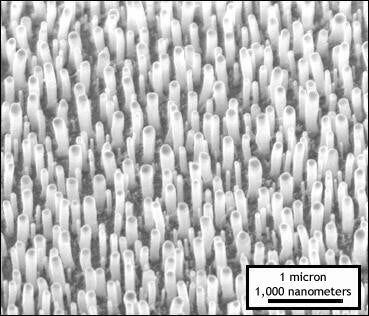Tracking Spirit
On Sol 62, as the Mars rover Spirit clambered over jumbled ejecta around Bonneville Crater, the Mars Global Surveyor flew overhead. Using an innovative technique, the orbiter snapped an image that shows both the rover and its track across the martian surface.
“Over the past year and a half, the camera and spacecraft teams for Mars Global Surveyor have worked together to develop a technique that allows us to roll the entire spacecraft so that the camera can be scanned in a way that sees details at three times higher resolution than we normally get,” said Ken Edgett, staff scientist at Malin Space Science Systems, San Diego, California, which built and operates the Mars Orbiter Camera.
Called cPROTO, for “compensated Pitch and Roll Targeted Observation,” the technique pitches the spacecraft along its ground track and simultaneously rolls it to keep a specific target in view. Controllers time both maneuvers to compensate for the apparent motion of the camera’s target.
“The image-motion compensation is tricky, and the spacecraft does not always hit its target. However, when it does, the results can be spectacular,” Edgett said. Because the maneuvers are complex, and the amount of data that can be acquired is limited, the technique is not used for most images.
Mars Global Surveyor has been productive longer than any other spacecraft sent to Mars. It has returned 170,000 images — more than all previous Mars missions combined. A third mission extension for the long-lived spacecraft continues operations through September 2006. For a larger version of the Spirit image, as well as others taken with the Mars Orbiter Camera, visit Malin Space Systems on the web. — Francis Reddy
A quarter-century after it was dedicated, the 3.2-meter (105 inch) Canada-France-Hawaii Telescope (CFHT) is producing some of the best wide-field and high-resolution images of the universe from the ground. The telescope resides at one of the world’s best locations (Hawaii’s Mauna Kea), but the key ingredient is a 340-megapixel digital camera called MegaCam, built in 2003. The instrument mosaics 36 CCD imaging chips to cover an area of sky 1° square, or twice the width of the Full Moon.
In 2003, MegaCam and CFHT began a multi-year project called the Canada-France-Hawaii Telescope Legacy Survey. In all, about 500 nights spaced over 5 years will be spent on three surveys. These will examine the entire ecliptic band (1,300 square degrees: the Very Wide survey), three selected regions of sky (170 square degrees: the Wide survey), and four deep fields (4 square degrees: the Deep survey). The surveys’ first data will be released in August 2006, but selected images are being released today, on the telescope’s 25th anniversary. — Robert Burnham
In a report to the Senate subcommittee on Science, Technology and Space Science, the Congressional Budget Office (CBO) stated sending astronauts back to the Moon would cost $100 billion. That’s 57 percent more than NASA’s estimate and approaches, in 2005 dollars, the cost of the Apollo program through 1969.
President Bush unveiled his plan for returning to the Moon January 14. In it, he calls for NASA to complete the International Space Station and retire the space-shuttle fleet by 2010. Money used for shuttle missions would then be directed into developing the capabilities needed for sending astronauts to the Moon by 2020.
In part, the CBO analysis reflects a need to redevelop Apollo-like capabilities: a rocket capable of lofting 100 tons into space, a new space vehicle for human travel to the Moon, and a new lunar lander. However, when Congressional analysts took a look at how well NASA controlled costs on 72 projects dating back to the 1970s, they found that, on average, costs ran over budget by about 45 percent. They then increased the budget estimate by the same factor.
Not surprisingly, NASA’s more complex programs tend to experience greater cost overruns. For example, the Hubble Space Telescope, the Galileo mission to Jupiter, and the cutting-edge X-38 crew-return vehicle ran 200 percent or more over their original budgets. But the agency’s fiscal record also suggests experience brings savings: Total costs for the space shuttle Endeavor, Mars Global Surveyor, Ulysses, and the Cassini-Huygens mission to Saturn were all less than their original budgets, according to CBO figures.
Much of the funding for the new space initiative comes from within the space agency itself, by redirecting an estimated $11 billion within its own budget. According to a National Research Council report released September 22, missions designed for basic research in solar physics and space weather may be the first to fall victim to NASA’s shifting focus. — Francis Reddy
More hurricane preparation
With Hurricane Jeanne expected to hit central Florida Sunday, September 26, Kennedy Space Center (KSC) staff engages in what has become a tragic habit — preparing for the oncoming storm’s wrath.
NASA has sent most KSC employees home to prepare for Jeanne. Personnel whose duties include hurricane preparedness are required to stay and complete their tasks. Some tasks include placing plywood over windows, covering equipment with plastic, and relocating materials from previously damaged buildings into safer facilities.
Jeanne is the fourth hurricane in 45 days to make landfall somewhere in the state.
— Jeremy McGovern
Rovers get an extension
The twin Mars rovers Spirit and Opportunity have been working overtime for nearly 5 months after completing their initial 3-month assignment. Now, following a period when Mars has passed behind the Sun, NASA has extended funding for an additional half year of rover operations.
“Spirit and Opportunity appear ready to continue their remarkable adventures,” explains Andrew Dantzler, NASA’s solar system division director. “We’re taking advantage of that good news by adding more support for the teamwork here on Earth that’s necessary for operating the rovers.”
The rovers were not driven during the 12-days Mars was behind the Sun because radio signals were unreliable. The nearly 2 weeks were a nervous period for the rover team. Not only were communications interrupted, but the rovers also were going through the worst time of winter in the martian southern hemisphere in terms of gathering solar energy.
Routine operation of Spirit and Opportunity resumed September 20 and will continue through an uncertain, but rewarding, future.
“We really don’t know how long they will keep working, whether days or months,” says Jim Erickson, project manager for both rovers. “We will do our best to continue getting the maximum possible benefit from these great national resources.”
— Jeremy McGovern
An antenna for visible light
Boston College scientists have observed a rudimentary antenna effect for visible light using an array of 50-nanometer-wide carbon tubes. Infalling light produced tiny electrical currents in the array.
The device works on the same principle as a simple dipole radio antenna. Radio waves fall on the antenna, exciting electrons into an electrical current that can be amplified and tuned to boost the incoming signal. The process is most efficient when the antenna’s length is close to the wavelength of the desired signal. When wavelengths span many meters, as in radio and television broadcasting, this is not much of a problem, but visible light has wavelengths of hundreds of nanometers. The nanotubes used in the experiment are essentially little antennae about 50-nm wide and hundreds of nanometers long. A typical human hair measures about 50,000 nanometers across.
Yang Wang, who led the team reporting the finding, says direct measurement of light-stimulated electrical excitations in the array requires technology that doesn’t yet exist — specifically, nanodiodes capable of oscillating at petahertz (PHz, or 1015 Hz) frequencies. But the team did observe secondary radiation emitted by the faint currents.
Possible applications for a visible-light antenna include efficient solar-energy conversion, transforming incoming sunlight into a charge stored in a capacitor. The team reports its findings in the September 27, 2004, issue of Applied Physics Letters. — Francis Reddy
Space station addition ready
A ceremony September 6 in Italy will mark the completion of a European-built cupola destined for the International Space Station (ISS). The module’s windows will provide panoramic views through which astronauts can control the station’s robotic arm and conduct Earth observations and other science. The addition also will house hardware crewmembers can use to communicate with each other throughout the station and during space walks. The project was a barter between the European Space Agency (ESA) and NASA; ESA built the cupola in exchange for transportation of European equipment to ISS aboard the shuttle. After the module is transferred to the Kennedy Space Center in Cape Canaveral, Florida, it will receive a final set of checks and then be put into storage. Launch is slated for January 2009. — Laura Baird
The Moderate Resolution Imaging Spectroradiometer (MODIS) instruments aboard NASA’s Terra and Aqua satellites have detected the red fluorescence of phytoplankton. Human eyes cannot see the red fluorescence produced by the marine algae’s chlorophyll.
Phytoplankton is a concern when found in huge concentrations, known as “red tides,” because it can cause skin and respiratory problems in humans and kill sea life, sometimes decimating local fish populations. During substantial phytoplankton blooms, the algae population is so intense that the water may appear black. The algae dies, sinks to the bottom, and is devoured by bacteria. The increased bacteria deplete the oxygen from the water, killing fish.
According to the study conducted by Chuanmin Hu and Frank Muller-Karger, oceanographers at the University of South Florida, monitoring the red fluorescence can provide early warnings for scientists, fishermen, and swimmers about developing cases of red tides that occur within plumes of dark-colored runoff from rivers and wetlands.
— Jeremy McGovern
Disrupted communication with Mars rovers anticipated
When Mars passes close to the Sun September 16, the energized environment surrounding our star may impede radio communication between mission planners and the twin Mars Exploration Rovers, Spirit and Opportunity. For several days on either side of this orbital alignment, called a conjunction, scientists on the ground will receive a respite from sending daily plans to the two spacecraft. Instead, the rovers will be preprogrammed to collect data.
Spirit and Opportunity will continue to communicate with the Mars Odyssey orbiter daily as well as try to communicate with Earth directly. Complete science teams will be listening in case they need to intervene in an emergency. To be on the safe side, plans have the rovers remaining stationary during the blackout, possibly moving the camera masts but neither the wheels nor robotic arms.
Meanwhile, a pebble stuck in Opportunity’s rock abrasion tool was jarred loose after a 2-week standstill. Mission scientists had planned to run the tool’s rotors in reverse to dislodge the small stone, but the rover’s regular motions shook it loose before they had the chance. A wire brush on the tool was used to clean some rocks in Endurance Crater on Monday, and subsequent data confirmed the tool is fully functioning. — Laura Baird













